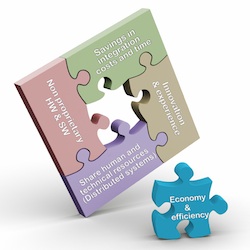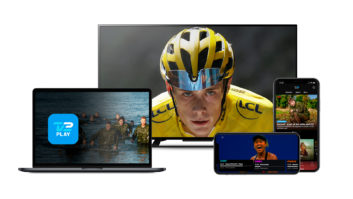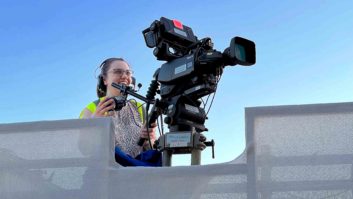
Taking advantage of the latest technological advances, VSN believes its Spider project brings a new generation of automation solutions to TV stations, generating important benefits to broadcasters and content producers alike. By Pedro Serrano, vice president, VSN.
1. Tapeless 1.0 (2000-2010)
IT technologies reached TV channels much later than expected due to the size of their video files and the need to manage large volumes of data for digitisation and processing purposes. In the 90’s of the last century, available software applications only allowed for basic control of VTRs and tape libraries. The existing nonlinear editing systems worked independently, always using videotapes as the source and target of their work. In news production workflows, NRCS systems only managed text and rundowns making it difficult to integrate with edited video.
With the advent of Gigabit Ethernet popularisation, a first generation of media asset management, automation and file transfer to video server software appeared which has been used during the first 10 years of the 21st century to digitise many productions, playout and archive TV areas. Video servers to replace VTRs and better storage units and network infrastructure sparked off the first ‘tapeless’ systems that would connect different operation areas (post production, archive, master control…) across networks at 1000Mbps. VSN was one of the first manufacturers to propose the tapeless concept back in 2001, when it was seen just as wishful thinking for many.
Proprietary hardware architecture from different manufacturers, the multiplication of SD and HD digital video formats and multiple non-standard specific communication protocols are a nightmare for technical managers and integrators of broadcast systems sometimes. The hypothetical benefits in terms of efficiency and speed (therefore, economic benefits) vanish due to slow implementation and start up, scarcity of training to make users adapt to the new roles in the process, and reluctance from some of the users.
On the other hand, the debate arose in many TV companies among those in favour of integrating the best elements (individually) of different manufacturers and those who argued that ‘the fewer manufacturers within the system, the fewer integration issues we will encounter, thus shortening our implementation and training cycles’.
As with any other technology changes, digitisation was often performed by areas in many companies (master control, production, archive, etc.) without a global business view, and, commonly, ignoring the development, administration and rights management areas – i.e. the non-technical or management areas.
It goes without saying that the possibility of remote work environments was not even considered in the first tapeless generation but through the use of very expensive RF link connections or satellites that allow the transfer of files or streaming video in an efficient way. All integrated solutions are restricted to the LAN (local area network) domain.
We have witnessed a dramatic evolution in software development tools over the last decade in the field of Informatics. But these advances have not yet been implemented in most systems currently in use in many TV channels.
Current technologies like web services, xml, user interfaces created using Silverlight or the like, can be hardly found in the broadcast market. Quite often, the age of a solution is taken as an indicator of its robustness, especially in the news and master control automation areas.
2. Competitive environment of the broadcast market in 2010
Over the last few years, the internet has caused a cataclysm in the world of conventional TV broadcasting. Audience fragmentation, IPTV, multicast platforms and multidistribution are the real bugbears broadcasters are facing today. The environment is more competitive than ever before, which has brought about a clear specialisation among producers, content distributors, carriers, etc.
Among some of the consequences we can mention the need for better media asset management systems (in multiple qualities), and the need for commercial and planning departments to take a more prominent role for a quicker management of unexpected events, latest news and new sponsoring/advertising methodologies.
To conclude, traffic solutions must be closely integrated with the master control operations; merely sending an xml file (a playlist) to the master control and receiving a similar file (an AsRunLog) is not enough. Likewise, the most powerful companies in the field publish their RFP contents (request for proposal) with a common denominator: the need to put into operation workflows adapted to their staff, environment and special circumstances.
So far, the choice of a provider commonly meant the necessity to adopt the workflow suggested by the manufacturer. Furthermore, said workflow could not be changed or implementing customisation was just very expensive.
These new circumstances allow for companies offering BPM (Business Process Management) to prosper: the paradigm of customised solutions’ development and the flagship of large consultancy firms. Unfortunately, it still needs to be proved that standard BPM tools can be reliably and efficiently integrated in a broadcast solutions’ ecosystem.
Thanks to impressive improvements in Internet connections and lower prices, many industrial environments are adopting ‘cloud management solutions’, which will enter the broadcast world sooner or later to stay. In the last few years, new technologies have also emerged that allow the adoption of affordable IP environments (ADSL, 3G, etc.) for transferring high quality content and helped get rid of satellites, courier services, etc.
Take for instance the case of VSNIPTRANSFER, currently in use in more than 200 TV channels in Spain and abroad. This sort of application fights the core of exploitation costs and allows for the delocalisation of production centres and contribution at reasonable costs.
Likewise, the proven maturity and experience of engineering departments to undertake digitisation projects makes it difficult for everyone to unquestioningly swallow any proposals or accept the imprecise habitual marketing documentation coming from many manufacturers. The demand for open platforms and non-proprietary interoperability protocols is an essential condition in all new projects.
3. Tapeless 2.0 (2010)
Nowadays, VSN is well-known for having promoted open technologies and defended tapeless environments for more than 10 years. In view of the current competition in the broadcast market, VSN undertook the radical renovation of its automation software, traffic, MAM, content production and video servers’ offer. The new generation of solutions should accomplish a few basic assumptions:
- Allowing TV production and playout by means of distributed resources, in multi-centre environments
- In particular, facilitating multiplatform content distribution
- Easy and efficient customisation of each customer’s workflow.
- Boundless integration of multiple areas (traffic, MAM, automation, etc. without duplicating tasks)
- Affordable cost of property throughout the whole life cycle of the technology, including a model of ‘cloud services’ for applications like Contribution, Archive, etc.
- Optimal exploitation of existing systems
- Complying with proven market standards
- Open systems (even to third-party manufacturers) and fully scalable at reasonable cost
The integration of the first four points of the previous list, keeping the known points five through eight and the use of state-of-the-art programming techniques available today, defines the new Tapeless 2.0 generation of software solutions, which are set to create a new standard in broadcast automation and digitisation. The R&D project developed by VSN to undertake this transformation is called Spider.
Spider proposes an SCS (Spider Central Server), where most applications (or ‘services’) of any company are installed or get connected to. The work environment is now called Ecosystem and it is accessible to any user with the appropriate permissions either locally or remotely. The applications in this ecosystem ‘talk to each other’ via web service-type open protocols (SOA, REST, etc.) or via simple interfaces like xml and official protocols like BXF.
The goals of the different modules developed under the Spider paradigm are the following:
- Gaining levels of integration among the different areas unheard of so far, especially among the traffic, MAM and automation areas
- Offering workflows adapted to every customer in an easy and affordable way (BPM)
- Non-proprietary hardware and software platform
- Totally public and open protocols, gateways and interfaces (an ‘Ecosystem’ with gateways concept)
- Modern interfaces of extensive usability (using web technologies, Silverlight, etc.)
Since the end of 2010, VSN has begun publishing the new versions of its modules compatible with the Spider platform. The project is planned to be finished at some time during 2011. VSN will be presenting all the new products that make up the second generation of tapeless solutions at the different trade shows and exhibitions in 2011; all of this thanks to an unprecedented R&D effort in the TV and broadcast sector.







